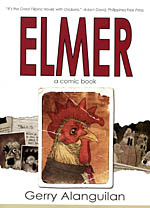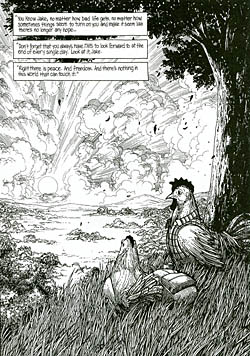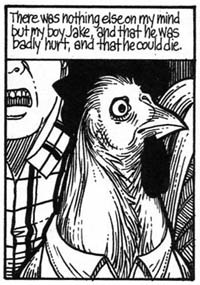 By Gerry Alanguilan
By Gerry Alanguilan
144 pages, black and white
Published by SLG Publishing
I’ll start by addressing the proverbial elephant in the room when it comes to Gerry Alanguilan’s Elmer. Yes. It’s a book where the main character is a talking chicken. And no, it’s not a comedy. It’s actually a clever alternate history from Alanguilan, answering a question that seems simple enough on the surface but turns out to be anything but: what would happen if chickens suddenly gained full sentience and could speak? What results from this simple premise turns into an excellently written and drawn story that will pull just about any reader into its pages.
 While Elmer does start with a bit of a gimmick (telling the first few pages from Jake Gallo’s perspective so it’s not until the view of the scene flips that we see it’s a chicken and not a person talking), the book otherwise takes its subject quite seriously, avoiding chicken puns, jokes, and other sorts of trickery. It’s easy in some ways to compare Elmer to other books about minorities who are trying to stand up and fight for their rights. Elmer does have a lot to thank from those works and history in general, using them as inspiration in several places as we learn about what happened on that fateful day in 1979 when chickens everywhere transformed into beings who could communicate with humans.
While Elmer does start with a bit of a gimmick (telling the first few pages from Jake Gallo’s perspective so it’s not until the view of the scene flips that we see it’s a chicken and not a person talking), the book otherwise takes its subject quite seriously, avoiding chicken puns, jokes, and other sorts of trickery. It’s easy in some ways to compare Elmer to other books about minorities who are trying to stand up and fight for their rights. Elmer does have a lot to thank from those works and history in general, using them as inspiration in several places as we learn about what happened on that fateful day in 1979 when chickens everywhere transformed into beings who could communicate with humans.
But there’s more to Elmer than just a book on prejudice that uses chickens in place of another minority. After all, chickens are a species that humanity have been eating for an extremely long time. And when the switch finally occurs, it doesn’t magically wipe out all of the chicken plants and farms, or restaurants, or recipe books, or memories. The end result is that as Jake reads his father Elmer’s diary and learns about what happened in those early days, it’s a much more violent response than you might otherwise imagine. This is a story that involves the massacres of sentient beings, over and over again, and Alanguilan doesn’t flinch from telling that logical extrapolation of his initial idea.
Alanguilan switches between Elmer’s story of the change, and Jake’s own experiences in the book’s present-day time of 2003. It’s hard to not find yourself more eager to switch back over to the flashbacks as you read Elmer; Jake isn’t as compelling a character, even though he’s a necessary one for the book to occur. Jake serves as a contrast to the earlier times, so even as he complains about his own problems we can see what Elmer and the other chickens went through in the 1980s.  Alanguilan also is able to use Jake as a voice of confusion when it comes to how the modern day chickens are mixing with humans, and the relationships that are forming. It’s hard to believe that romantic relationships between humans and chickens would go unquestioned, but by letting Jake be the one to voice concerns (instead of just bugbears on newscasts) it allows Alanguilan to bring up these ideas in a way that make the reader think and try and address their own thoughts on the matter, rather than simply brush them off as being spoken by a "bad guy" and moving on.
Alanguilan also is able to use Jake as a voice of confusion when it comes to how the modern day chickens are mixing with humans, and the relationships that are forming. It’s hard to believe that romantic relationships between humans and chickens would go unquestioned, but by letting Jake be the one to voice concerns (instead of just bugbears on newscasts) it allows Alanguilan to bring up these ideas in a way that make the reader think and try and address their own thoughts on the matter, rather than simply brush them off as being spoken by a "bad guy" and moving on.
Up until now I’ve only been familiar with Alanguilan as an inker, working with artists like Whilce Portacio and Leinil Yu, but Elmer shows that he’s a talented penciler as well. His chickens are drawn with a lot of care and detail, something that’s critical for Elmer to succeed. By giving them expressive faces and postures, it helps sell the drama that the characters are going through, another reminder that the chickens are now thinking, fully-aware beings instead of mindless animals. It’s interestingly enough the humans who come across a bit cartoonish in places, with much simpler faces and bodies. Then again, this is a book being told by the perspective of a chicken. Still, even with the simpler approach to people in the book, Alanguilan’s able to deliver the emotional charged scenes involving humans whenever necessary. Add in some attractive backgrounds and scenery that bring the Philippines and you’ll end up getting fully drawn into the world of Elmer.
I’d heard about Elmer several years ago, but had figured I’d never see a North American edition of the book (first published in the Philippines). I’m delighted to be proven wrong, though; Elmer is as excellent as I’d heard it was, if not more so. Alanguilan’s a talented writer and artist, and while seeing pages inked by him is always a pleasure, I know I’ll be looking for more books written and drawn by Alanguilan as well. This is a good book with which to round out the year.
Purchase Links: Amazon.com | Powell’s Books
